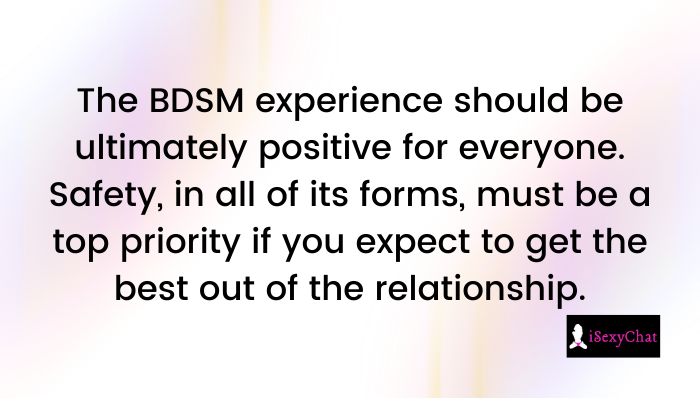“Put it in writing.”
It’s a line we often hear from someone who has an eye for detail and wants things to be crystal clear and, most importantly, official. Contracts are what come to mind when we think of written agreements. We see them as extremely important and useful documents which possess great legal weight.
From opening a bank account to signing a lease, contracts play a huge part in an adult’s daily life. However, their usefulness can extend far beyond the mundane matters with which they’re normally associated. In the BDSM community, an agreement between partners can also be put into writing. Yes, you can employ the binding powers of a contract even for erotic pleasure.
But how does one go about writing a BDSM contract? What is its scope? Is it even really required for a dominant (dom) and a submissive (sub) to get the best out of their sexual exploits? We’ll answer these questions and then some in this post.
What’s the Point of Dominant/Submissive Contracts?
You may think paperwork throws a wet towel over the whole endeavor. Contracts hardly equate to sexual pleasure. But know that you don’t need a signed agreement before you can commence with BDSM relationships. You involve contracts in BDSM mainly in the interest of clarity. Here are several other reasons why BDSM contracts can be good for you.
They establish the terms and rules of the relationship
You set expectations and goals and the means to achieve them in a contract. It clarifies the extent of the dom’s power over the sub. On the other hand, it can also stipulate what the sub is willing to do and what lines should never be crossed. Determining the soft and hard limits within a power exchange relationship can be tricky for beginners. A lot can be lost in a verbal agreement. Putting everything on actual paper will most likely eliminate the confusion regarding who gets to do what.
They’re sort of a relationship guide
If you and your partner are in a serious relationship, you may think a written document detailing how hard spankings should be is hardly a tool for enriching your connection. The truth is you’ll be surprised at the things that come to the surface when you’re drafting a BDSM contract.
BDSM can be considered an extreme display of affection. It virtually bulldozes the coyness and reservations that you and your partner might have for each other. When these masks are removed, you see an entirely different side of the person you thought you knew.
Imagine your predominantly timid partner suddenly having strong opinions about their preferences in double-ended dildoes. You discover deeper likes and dislikes—vital information that you can put to good use outside of BDSM play. This can be very exciting and a likely source of growth for your relationship.

They’re essentially an extension of BDSM play
Much like how having your name on a real estate title is more or less indisputable proof of ownership and a great source of pride, BDSM contracts impart more legitimacy to your dom/sub dynamic.
They’re symbolic of the expanse and authority of the power exchange and not merely a noted-down articulation of its logistics. Your dedication to the kink reaches such incredible heights that you just have to put it in writing. It adds a bit more flavor to the experience.
Main Elements of a Dom/Sub Contract
Here are our recommendations for what you should include in your first BDSM contract.
Role and title of each participant
Immediately identify the people involved and what role they’ll assume in the duration of the contract. You may also include the general description of each role and what’s expected of it in this section.
Your title is how you’d like to be addressed. Nicknames may also be established at this point. For example, the dom may want to be referred to as “Mistress Black Widow” or simply “Mistress”. The sub may be called something along the lines of “The Footstool” or something a bit more affectionate, like “Little Dewdrop”.
General conditions
This is where you outline the rules and guidelines of your agreement. You can be as vague or specific as you see fit.
For instance, you can throw in a blanket rule like, “The sub agrees to do everything the dom commands.” Are you entering a total power exchange relationship wherein your dynamic applies even to your daily life or is it a strictly “in the bedroom” sort of a deal? Clarify it within this part.
You can also list down particular activities in which you’ll be partaking. State the involvement of food play, the specific ties that’ll come into play during bondage, chores, after-play care, etc. Go crazy with the details if that’s how you want things to play out. As a beginner, you may want things to be as clear as possible.

Punishment and rules of punishment
You can integrate this within the terms and conditions or have it as a separate article. This is the part where you state that the sub is liable to be punished if they fail to follow orders. Include the scope and limits of the punishment.
Limitations
As with punishment, this can go in the general terms and conditions as well. But it can also have its dedicated section.
This part is mainly concerned with the circumstances where the sub has the right to refuse commands they may deem abusive or outside the agreed terms. This is also where you can distinguish the soft limits from the hard ones. If there are legitimate safety concerns, this is where they fall in.
Effectivity
Just like with most agreements between two or more parties, the contract’s lifespan must be determined and clearly stated. Put down the commencement and conclusion dates. You can even include the exact times if you’re inclined.
Note that a contract can be short or long-term. It can govern the events of a single scene—making it a one-time use document—or it can span the entirety of the relationship.
Terms of termination
A BDSM contract can be terminated or nullified ahead of its natural lifespan through certain circumstances or actions of the involved parties. This is where you stipulate the conditions that would lead to termination. A line saying that the agreement is deemed terminated if all involved individuals agree that the conditions within are no longer viable is normally included in this section.
Terms of alteration
State whether or not individual conditions or entire sections are open to modification. Indicate the actions you need to take if changes should be made. Do you make a new contract or will handwritten notes approved and cross-signed by all parties suffice?
Health declaration
If you don’t know your partner all that well, you may want to include this in your contract. State that you’ve both been tested and are free from sexually transmitted infections (STIs). This is extremely vital if your scene/s will involve penetration or bodily fluids.
Additionally, you can include other medical conditions that both the dom and sub should be aware of. For example, allergies should be declared in case of food play or if you’re going to use massage oils.
Apart from the physical state of the participants, you should also note emotional and psychological health factors. You or your partner may be working through emotional stress or psychological trauma while the contract is in effect. It’s important to draw solid lines in this case. Clarify which actions or words will trigger negative reactions and avoid them meticulously. Also, if it’s absolutely necessary, don’t hesitate to include emergency contact information.
Don’t think of this part as a mood killer. The BDSM experience should be ultimately positive for everyone. Safety, in all of its forms, must be a top priority if you expect to get the best out of the relationship.

Privacy and discretion clause
It wouldn’t be surprising if you or your partner would want to keep the contents of the contract and the context of your BDSM lifestyle under wraps. You’re definitely allowed to have a non-disclosure clause in your agreement for whatever reason. You can stipulate that upon completion of the contract, all evidence of your interactions—including written documentation—shall be destroyed in the interest of secrecy.
You can include this part for practical reasons or simply for dramatic effect. It sprinkles a bit more spice onto your whole BDSM setup—like you’re being sly and are in constant fear of being found out and punished for your unorthodox lifestyle.
Kink list
If it helps, you can annex a list of kinks to the contract. You can refer to this list in the general terms to make things a bit more streamlined. This can either be a short or long list, depending on how deep you are into the BDSM lore.
This part is better expressed in table form. It works as a checklist of specific activities and fantasies that you’re open to exploring. Not only that, but you can also indicate the intensity to which you’re willing to go for each kink.
For example, once you’ve indicated that you’re open to trying anal plugs, also include how hard you’re willing to go on, say, a scale of one to five. It wouldn’t hurt to add a “comments” column.
Sample BDSM Contract
With the basics pat-down, have a look at this brief and simple example of a BDSM contract.
Contract of Voluntary Submission
This agreement of voluntary and total submission is between Sandra, the Dominant (herein referred to as “Madame” or other related forms), and Gene, the Submissive (herein referred to as “Heel” or other related forms).
Conditions of the Agreement
Heel, through this contract, binds himself to submission to Madame, relinquishes all privileges, prerogatives, and status to her, and swears to follow her commands within the limits indicated in this document.
Limitations
Heel holds the right to disobey Madame under the following circumstances:
- If the command is in direct conflict with existing laws
- If the command may cause extreme or irreversible physiological, emotional, or psychological damage to Heel or others
- If the command may adversely affect Heel’s family, social, and professional life
Responsibilities of the Dominant
Madame shall ensure the safety and well-being of Heel for the duration of this agreement. She shall respect all of Heel’s limits.
Madame holds sole responsibility in administering punishment to Heel should he fail to obey her orders or deliver unsatisfactory performances.
Punishment and Limits
Heel agrees to accept punishments from Madame unless they involve:
- breaking of the skin or drawing blood
- nuts or nut-related substances
- animals—living or otherwise
- withholding life-sustaining substances, including but not limited to food, water, air, and medication.
- superficial body marks that can’t be concealed by everyday clothing
Effectivity
This agreement shall take effect on the 1st of July, 2022, and end on the 1st of August 2022. Schedules shall be agreed upon and confirmed by both parties at least one day ahead.
Termination
This agreement shall conclude on the 1st of August 2022.
Both parties hold the right to pre-terminate this contract for whatever reason they see fit.
All copies of this contract, both physical and electronic, shall be destroyed upon completion or pre-termination.
By affixing their signatures, Madame and Heel, in sound body and mind, confirm agreement to all of the above.
Signed Submissive: Gene
Date:
Signed Dominant: Sandra
Date:
BDSM Contract Writing Tips for Beginners
Make it your own
There’s no one way to go around writing a BDSM contract. It’s quite flexible and can accommodate the vastness of the lifestyle. Experiences vary greatly, so you shouldn’t constrain yourself with a single contract.
Even if you practice BDSM with a single, long-term partner, you may want to shake things up by altering the conditions in the agreement after every cycle.
Perhaps you can start by having broad conditions in your first few contracts. And when you’ve gotten the hang of it, start crafting more creative stipulations, which are more tailored to your needs and wants.
As for style and format, you can be as casual or formal as you want. Unless you and everyone else involved in the written agreement have a firm grasp of legal jargon, you may want to keep things plain and simple as a newbie.
Making the contract sound extremely professional as though an actual lawyer wrote it does have its appeal, though. It will make it seem a lot more official, weighty, and a creative display of the power exchange dynamic. But the choice is yours.
As mentioned before, you can attach a kink checklist to the contract. It doesn’t have to stop there. Your entire contract can turn into a full-blown questionnaire if it makes things easier for you to set the conditions and limits.
If you’ve seen a real-life BDSM contract, you’ll notice that it’s highly dependent on very specific circumstances surrounding the parties involved. If you like learning about people, creating one can be an enjoyable task in and of itself.

Negotiate
Round up the edges by negotiating the terms of your contract. Keep an open line of communication with your partner while drafting the write-up. Hear each other out and be honest about the parts that you don’t agree with or would want to modify. BDSM should be a collaborative effort despite the strong presence of power play.
Be Reasonable and Watch Out for Red Flags
You can tell a lot about a dom from the terms they want to be included in the contract. So watch out for potentially abusive partners by dissecting their demands.
Terms like maintaining a certain weight or being on call 24⁄7 are largely unreasonable and should be called out. If the dom insists, then it’s probably not a relationship you’d want to be in.
At the same time, don’t demand something from your partner that you wouldn’t want to do yourself. Keep things sane and respectful.

Expect the worst and don’t play and write
Things hardly ever go the way they should. Don’t punish yourself too much if your scenes and interactions don’t coincide with what you’ve agreed upon in your contract. If you’re the overthinking type, you might be given to stressing out about how you messed up the contract.
This can have negative effects on your relationship, more specifically during BDSM play when you’re seeing the outcome of what you perceive as a botched agreement.
Keep your head in the game and avoid mentally drafting a new and better contract mid-play. Make the best of the situation and apply what you’ve learned in your next contract.
Parting Thoughts
Real-life BDSM contracts have no legal value. They are, for the most part, fiction on a piece of paper. At any time, any of the involved parties can simply opt out of it without prior notice or outright go against the agreed terms and they wouldn’t be breaking any real laws. They are, however, dishonoring and disrespecting the relationship.
The Safe, Sane, and Consensual (SSC) principles are several of the foundations of the BDSM way of life. More experienced members of the community prefer to throw in another “S” in there for Sober. They’re not just the cornerstones of kinks and sexual activities. They also stand as guides for creating and maintaining a good relationship between BDSM partners.
That’s why even though a BDSM contract is ultimately just a fantastical dressing, it’s still a significant social tool. It has the power to build, strengthen, or destroy connections. Keep that in mind before you sign a contract. Honor the trust that the BDSM contract represents and you’ll have a stronger and more fruitful bond with your partner.






